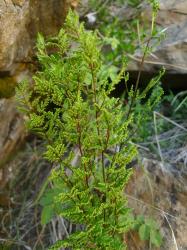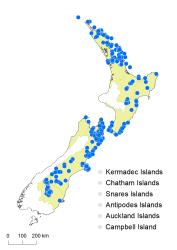- ≡ Cheilanthes tenuifolia var. sieberi (Kunze) Hook.f., Handb. New Zealand Fl. 362 (1864)
- ≡ Cheilanthes tenuifolia subsp. sieberi (Kunze) Domin, Biblioth. Bot. 20(85): 140 (1913)
- ≡ Hemionitis sieberi (Kunze) Christenh. in Christenhusz et al., Global Flora, GLOVAP Nomenclature 1, 4, 21 (2018)
- = Cheilanthes sieberi var. deltoidea J.B.Armstr., Trans. & Proc. New Zealand Inst. 12: 346 (1880) nom. nov. pro Cheilanthes tenuifolia sensu Kirk 1874
- = Cheilanthes kirkii J.B.Armstr., Trans. & Proc. New Zealand Inst. 13: 360 (1880) nom. nov. pro Cheilanthes tenuifolia sensu Kirk 1874
- = Cheilanthes venosa Colenso, Trans. & Proc. New Zealand Inst. 25: 321 (1893)
- = Cheilanthes erecta Colenso, Trans. & Proc. New Zealand Inst. 28: 619 (1896)
Rhizomes short- to long-creeping, up to 65 mm long (in herbarium specimens), 1–3 mm diameter, with stipes closely inserted; bearing appressed scales. Rhizome scales narrowly ovate, 1.0–2.5 mm long, 0.2–0.3 mm wide, dark brown with paler margins. Fronds monomorphic, 60–445 mm long, very rarely up to 590 mm long. Stipes 30–340 mm long, rarely up to 400 mm long, erect, rigid, red-brown; bearing concolorous orange-brown scales proximally, 2.5–5.0 mm long, 0.1–0.3 mm wide, scales becoming hair-like distally. Rachises red-brown, sulcate, bearing sparse hair-like scales up to 1.5 mm long. Laminae 30–250 mm long, 6–80 mm wide (sterile laminae rarely a little larger), 2-pinnate to 3-pinnate-pinnatifid, ovate or narrowly ovate or narrowly elliptic or linear, tapering to a pinnatifid apex, erect, dark green on both surfaces, coriaceous, bearing sparse, hair-like scales on the abaxial surface. Primary pinnae in 7–20 pairs below pinnatifid apex, widely spaced especially proximally, elliptic or ovate or broadly ovate; the longest between the middle and base, 6–70 mm long, 5–30 mm wide, apices acute, bases short-stalked, divided into secondary pinnae. Secondary pinnae decreasing in length along each primary pinna to the distal end; the longest secondary pinnae ovate or elliptic, 5–25 mm long, 4–10 mm wide, apices acute to obtuse, bases stalked, sometimes divided into tertiary segments. Tertiary pinnae elliptic or ovate, 1–10 mm long, 1–3 mm wide, apices obtuse, bases adnate or sessile. Sori extending around the pinna margins, discrete, oblong, protected by inrolled lamina segments, becoming ± continuous at maturity. 16 spores per sporangium.
Cheilanthes sieberi is distinguished from C. distans by the lack of hairs on the adaxial surface, and lack of narrowly ovate scales on the abaxial lamina surface. The fronds often appear glabrous to the naked eye, but there is usually a sparse covering of short, hair-like scales on the rachis and abaxial surfaces. The laminae are also generally longer, broader and more divided than in C. distans (30–250 mm long cf. 12–220 mm long; 6–80 mm wide cf. 6–33 mm wide). The two species frequently occur together, and both are rigidly upright ferns.
North Island: Northland, Auckland, Volcanic Plateau, Gisborne, Southern North Island.
South Island: Western Nelson, Sounds-Nelson, Marlborough, Canterbury, Otago.
Three Kings Islands
Altitudinal range: 0–825 m.
Cheilanthes sieberi occurs on the Three Kings Islands and in lowland districts of the North Island from Te Paki to Wellington, but is largely confined to the eastern half of the island. It grows from near sea level, reaching 825 m in the Kaimanawa Ranges. In the South Island it is confined to eastern areas from the Marlborough Sounds to Dunedin, growing from about 30 m and reaching 820 m near Tekapo.
Also Australia (Western Australia, Northern Territory, South Australia, Queensland, New South Wales, Australian Capital Territory, Victoria, Tasmania), Norfolk Island, Lord Howe Island and New Caledonia.
Cheilanthes sieberi grows on dry cliffs, rocky outcrops, roadside banks, shingle, and heated ground around fumeroles, often in sunny situations. It is found under kānuka, mānuka and scrub, and in grassland, often in coastal areas, and sometimes in full sun. It grows on greywacke, lava, pumice, basalt, mica schist, and limestone substrates.
Together with Anogramma leptophylla, Asplenium flabellifolium, A. subglandulosum, Cheilanthes distans and Pellaea calidirupium, Cheilanthes sieberi forms a characteristic assemblage of ferns that inhabits dry rocky areas, especially in the eastern South Island.
| Category | Number |
|---|---|
| Indigenous (Non-endemic) | 1 |
| Total | 1 |
Only one subspecies of Cheilanthes sieberi occurs in New Zealand. Cheilanthes sieberi subsp. pseudovellea is endemic to the arid region of central Australia. It is distinguished from subsp. sieberi by the presence of an indumentum of twisted hairs on both surfaces of the pinnules. By contrast, the adaxial surface of subsp. sieberi is glabrous, and the abaxial surface almost glabrous.
Large forms of C. sieberi in New Zealand were persistently misidentified as C. tenuifolia by earlier Flora writers, and especially by Kirk (1874), who thought that both species were present in New Zealand. However C. tenuifolia is found in coastal regions of Queensland and Northern Territory, Nepal, India, Sri Lanka, South-East Asia and the Pacific islands (Chambers & Farrant 1991).
Following Green (1988), the name C. humilis (G.Forst.) P.S.Green was used as an earlier name for C. sieberi by Brownsey & Smith-Dodsworth (1989), but Chambers & Farrant (1991, 1998) concluded that Forster’s type was typical of C. tenuifolia rather than C. sieberi.
Quirk et al. (1983) noted that examination of the type specimen of C. erecta “shows it to be somewhat intermediate between C. sieberi and C. distans, with a narrow, mostly glabrous bipinnate frond which bears some scales. Spores are rounded, and of an echinate pattern most like that of C. distans”.





